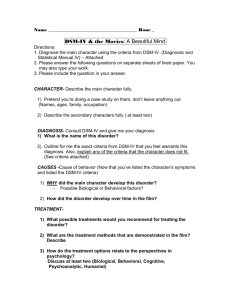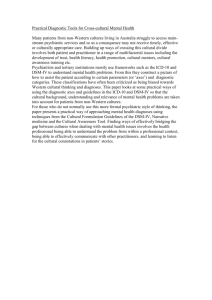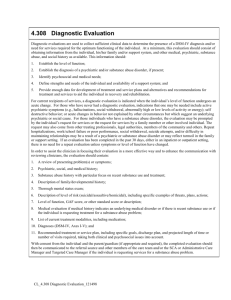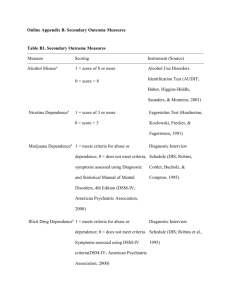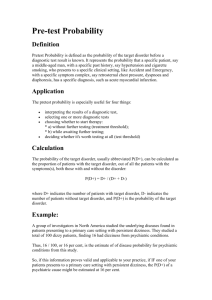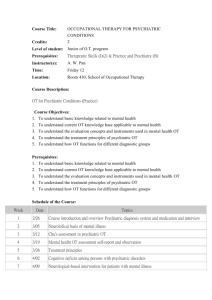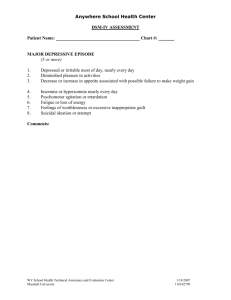Paraphilia NOS, Nonconsent: Not Ready for the Courtroom
advertisement
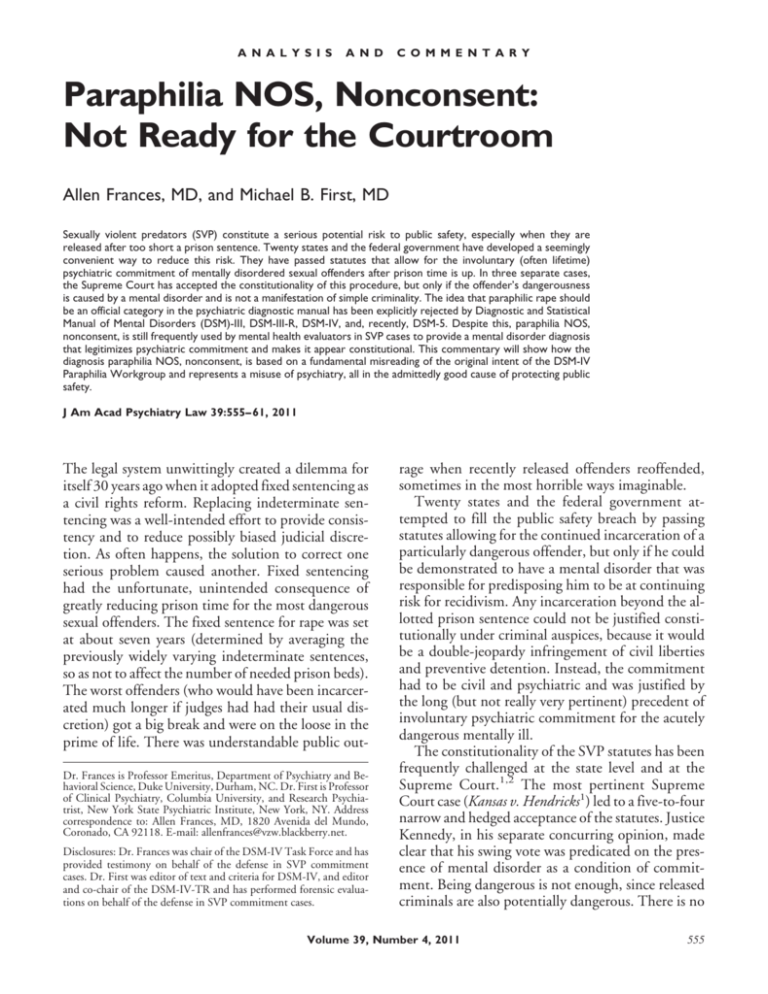
A N A L Y S I S A N D C O M M E N T A R Y Paraphilia NOS, Nonconsent: Not Ready for the Courtroom Allen Frances, MD, and Michael B. First, MD Sexually violent predators (SVP) constitute a serious potential risk to public safety, especially when they are released after too short a prison sentence. Twenty states and the federal government have developed a seemingly convenient way to reduce this risk. They have passed statutes that allow for the involuntary (often lifetime) psychiatric commitment of mentally disordered sexual offenders after prison time is up. In three separate cases, the Supreme Court has accepted the constitutionality of this procedure, but only if the offender’s dangerousness is caused by a mental disorder and is not a manifestation of simple criminality. The idea that paraphilic rape should be an official category in the psychiatric diagnostic manual has been explicitly rejected by Diagnostic and Statistical Manual of Mental Disorders (DSM)-III, DSM-III-R, DSM-IV, and, recently, DSM-5. Despite this, paraphilia NOS, nonconsent, is still frequently used by mental health evaluators in SVP cases to provide a mental disorder diagnosis that legitimizes psychiatric commitment and makes it appear constitutional. This commentary will show how the diagnosis paraphilia NOS, nonconsent, is based on a fundamental misreading of the original intent of the DSM-IV Paraphilia Workgroup and represents a misuse of psychiatry, all in the admittedly good cause of protecting public safety. J Am Acad Psychiatry Law 39:555– 61, 2011 The legal system unwittingly created a dilemma for itself 30 years ago when it adopted fixed sentencing as a civil rights reform. Replacing indeterminate sentencing was a well-intended effort to provide consistency and to reduce possibly biased judicial discretion. As often happens, the solution to correct one serious problem caused another. Fixed sentencing had the unfortunate, unintended consequence of greatly reducing prison time for the most dangerous sexual offenders. The fixed sentence for rape was set at about seven years (determined by averaging the previously widely varying indeterminate sentences, so as not to affect the number of needed prison beds). The worst offenders (who would have been incarcerated much longer if judges had had their usual discretion) got a big break and were on the loose in the prime of life. There was understandable public outDr. Frances is Professor Emeritus, Department of Psychiatry and Behavioral Science, Duke University, Durham, NC. Dr. First is Professor of Clinical Psychiatry, Columbia University, and Research Psychiatrist, New York State Psychiatric Institute, New York, NY. Address correspondence to: Allen Frances, MD, 1820 Avenida del Mundo, Coronado, CA 92118. E-mail: allenfrances@vzw.blackberry.net. Disclosures: Dr. Frances was chair of the DSM-IV Task Force and has provided testimony on behalf of the defense in SVP commitment cases. Dr. First was editor of text and criteria for DSM-IV, and editor and co-chair of the DSM-IV-TR and has performed forensic evaluations on behalf of the defense in SVP commitment cases. rage when recently released offenders reoffended, sometimes in the most horrible ways imaginable. Twenty states and the federal government attempted to fill the public safety breach by passing statutes allowing for the continued incarceration of a particularly dangerous offender, but only if he could be demonstrated to have a mental disorder that was responsible for predisposing him to be at continuing risk for recidivism. Any incarceration beyond the allotted prison sentence could not be justified constitutionally under criminal auspices, because it would be a double-jeopardy infringement of civil liberties and preventive detention. Instead, the commitment had to be civil and psychiatric and was justified by the long (but not really very pertinent) precedent of involuntary psychiatric commitment for the acutely dangerous mentally ill. The constitutionality of the SVP statutes has been frequently challenged at the state level and at the Supreme Court.1,2 The most pertinent Supreme Court case (Kansas v. Hendricks1) led to a five-to-four narrow and hedged acceptance of the statutes. Justice Kennedy, in his separate concurring opinion, made clear that his swing vote was predicated on the presence of mental disorder as a condition of commitment. Being dangerous is not enough, since released criminals are also potentially dangerous. There is no Volume 39, Number 4, 2011 555 Paraphilia Not Otherwise Specified, Nonconsent constitutional justification for civil psychiatric commitment unless a mental disorder is present. The statutes cannot be used to detain common criminals who remain dangerous. The trick is how to define mental disorder so that it separates those eligible for psychiatric commitment from the common run of criminals who must be released for constitutional reasons when their time is up, regardless of the risk they continue to pose. The rub is that there is no good, conceptually clear, and operational definition of mental disorder, either in psychiatry or in the law. The Supreme Court made clear that the legal system need not be limited to medical or psychiatric definitions, but then completely dodged the crucial question of how mental disorder should be defined and diagnosed in legal proceedings. Presumably, the definition would be left to the states to decide, but that it does not help very much. The state statutes all use almost exactly the same words to define mental disorder and do it in language that is impossibly vague and provides no real guidance. Nor can we look to the medical community for much help in providing a bright line. The Diagnostic and Statistical Manual of Mental Disorders, Fourth Revision, Text Revision (DSMIV-TR),3 introduction states that “it must be admitted that no definition adequately specifies precise boundaries for the concept of ‘mental disorder’.” It “lacks a consistent operational definition that covers all situations” [Ref. 3, p xxx]. In summary, the legal system is using questionably constitutional civil commitment statutes as a bailout to solve the problem created by fixed sentencing (and the resulting short prison terms for the most dangerous sex offenders). The legitimacy of the statutes depends completely on the offender’s having a mental abnormality, but the states’ definition of what is meant by “mental abnormality” is, as just stated, impossibly vague. The Supreme Court has refused to take advantage of its several opportunities to produce a clear legal definition. Lacking an operational legal definition of mental abnormality, the default position for mental health SVP evaluators and for the courts is to rely on the DSM-IV-TR. In practice, the statutes are triggered only if it can be determined that the offender qualifies for a DSM-IV-TR diagnosis. Which brings us to the purpose of this commentary: to explain why the widespread use of paraphilia NOS, nonconsent, as a qualifying diagnosis in mental health proceedings is inappropriate and based on 556 a misunderstanding of the wording and intent of Diagnostic and Statistical Manual of Mental Disorders, Fourth Edition (DSM-IV).4 The Origins of Paraphilia NOS, Nonconsent, as Grounds for Civil Commitment As Chair and Editor of the Text and Criteria in DSM-IV, we are ultimately responsible for much of the confusion. The wording of the DSM-IV Paraphilia section was written long before the issue of SVP commitment arose and was written with clinicians, not forensic proceedings, in mind. We were not aware of the consequential problems that would later arise from the fact that the section lacked the clarity and precision necessary for legal purposes. The inartful wordings allowed many evaluators in SVP determinations to misread seriously what DSM-IV was actually trying to convey.5 The DSM-IV Paraphilia Workgroup had definitively rejected the claim that rape should be considered a mental disorder, but a misreading of the poorly worded paraphilia section allowed evaluators to form just the opposite impression: that rape could often be considered a form of paraphilia. There was then an unfortunate snowballing, fad effect. The fact that paraphilia NOS, nonconsent, has been widely used (really misused) by the community of SVP evaluators has given it an undeserved aura of authority and acceptability. Much has been made in legal settings of the wording of the opening sentence of the DSM-IV-TR paraphilia section. “The essential features of a paraphilia are recurrent, intense, sexually arousing fantasies, sexual urges, or behaviors generally involving 1) nonhuman objects, 2) the suffering or humiliation of oneself or one’s partner, or 3) children or other nonconsenting persons” (Ref. 3, p 566). This sentence has been erroneously taken to be some kind of authoritative DSM-IV-TR definition of paraphilia and is then used to justify the diagnosis of a qualifying mental disorder called paraphilia NOS, nonconsent, under the mistaken assumption that the text implies that the DSM-IV-TR recognizes the existence of an arousal pattern focused on the nonconsenting nature of the sexual behaviors. In fact, it was never anticipated that the opening sentence of the section would be considered a forensic definition of paraphilia or be used in determining the suitability of long-term psychiatric incarcera- The Journal of the American Academy of Psychiatry and the Law Frances and First tion.6 It was meant instead as no more than a simple table of contents to summarize the specific types of paraphilias included in the DSM-IV, sorting them by deviant arousal pattern into convenient categories. “Nonhuman objects” referred to fetishism and transvestic fetishism; “suffering and humiliation ” covered sadism and masochism; and “children and other nonconsenting persons ” covered pedophilia, exhibitionism, voyeurism, and frotteurism, all of which happen to involve nonconsenting individuals. Doren provides the clearest and most influential illustration of mistaken interpretation of these sentences. Noting that “for whatever reasons, the DSM-IV failed to enumerate separately a paraphilia related to raping,” he poses the question, “does this mean that DSM-IV totally omits such a condition?” (Ref. 5, p 65). Doren answers his own question with an authoritative-sounding “no,” asserting that “the DSM-IV does include a paraphilia related to rape within its definitional paragraphs” (Ref. 5, p 65). After quoting the introductory sentence noted above, he concludes that “this set of phrases clearly relates to defining characteristics of voyeurism and exhibitionism” and “also define a type of ‘nonconsent,’ however, that pertains to raping as well” (Ref. 5, p 65). As noted above, this was most certainly not our intention. The phrase was not at all meant to include rape and instead describes only the victims of exhibitionism, voyeurism, frotteurism, and pedophilia. In fact, it was the deliberate intent of DSM-IV to exclude any reference in DSM-IV to rape as a paraphilia. That is why rape is not listed under the various examples of paraphilia NOS and is not listed in the DSM-IV Index. Complicating matters, a small editing mistake in the DSM-IV A criterion for paraphilias (i.e., the erroneous use of “or” instead of “and” to join the list of fantasies, sexual urges, behaviors)7–9 has encouraged some forensic evaluators to claim that a diagnosis of paraphilia NOS, nonconsent, can be made based solely on the fact that the person committed rape, without any attempt to establish that the person is in fact sexually aroused by nonconsensual sex. Indeed, noting that “evaluators do not typically enjoy the benefit of a truly honest disclosure of the subject’s sexual fantasies and urges,” Doren recommends that “examiners most commonly need to rely on documentation of the subject’s behaviors alone instead” (Ref. 5, p 66). Again, this was not the intent of DSM-IV. The Forensic Misuse of NOS Categories DSM-IV includes 46 not otherwise specified categories to allow clinicians to diagnose and code patients who do not fit well into any of the official categories. This is based on clinical judgment alone, with no criteria provided. NOS diagnoses apply for presentations that are subthreshold, atypical, of uncertain etiology, or based on insufficient information. The NOS categories are provided because psychiatric presentations are so various and idiosyncratic. It would be impossible to have specific labels for every conceivable presentation. Not otherwise specified diagnoses are meant to be no more than residual wastebaskets provided by DSM-IV to encourage research and for the convenience of clinicians when coding patients who do not fit within one of the specific DSM-IV categories. Here is all that DSM-IV-TR says about paraphilia NOS: “A residual category, Paraphilia Not Otherwise Specified, includes other Paraphilias that are less frequently encountered” (Ref. 3, p 567) and “examples include, but are not limited to telephone scatologia, necrophilia, partialism, zoophilia, copropophilia, klismaphilia, and urophilia ” (Ref. 3, p 576). DSM-IV specifically did not include either rape or nonconsent as an NOS example, because paraphilic rapism had been considered and ruled out as a paraphilia in Diagnostic and Statistical Manual of Mental Disorders, Third Edition (DSM-III),10 Diagnostic and Statistical Manual of Mental Disorders, Third Edition, Revised (DSM-III-R),11 and DSM-IV.4,12 We did not want to provide any backdoor opening for its use via NOS. The problem is that paraphilia NOS has been widely misapplied in SVP hearings to criminals who have no mental disorder by evaluators who have misinterpreted DSM-IV. Psychiatric diagnoses from the DSM-IV-TR are generally considered admissible in court because they are accepted by the field at large as widely recognized, clinically valid categories that can be reliably assessed. By virtue of their residual and idiosyncratic nature, cases given the label of NOS are by definition outside of what is generally accepted by the field as a reliable and valid psychiatric disorder. Furthermore, the NOS categories do not have criteria sets and therefore can never be diagnosed reliably. Because it is unlikely that different evaluators would Volume 39, Number 4, 2011 557 Paraphilia Not Otherwise Specified, Nonconsent agree on a paraphilia NOS diagnosis, there is no reason to accept the NOS diagnosis of any given evaluator. The use by evaluators of the paraphilia NOS diagnosis fails to satisfy the standards that should be required for expert testimony. Clearly this misuse must be corrected if we are to protect the integrity of psychiatric diagnosis and the inviolability of constitutionally guaranteed civil rights. The question arises of whether paraphilia NOS, nonconsent, should ever play a role in SVP proceedings (i.e., whether it should ever be allowed by judges and ever be taken seriously by juries). The argument for not entirely excluding paraphilia NOS is that, very occasionally, there may be a rapist whose behavior actually is motivated by paraphilia (i.e., he is able to achieve sexual arousal only or primarily when fantasizing about or performing the act of rape). The argument for rejecting all forensic use of the diagnosis paraphilia NOS, nonconsent, is that allowing these exceptions provides a backdoor invitation to its continued shameful and widespread misapplication to all the many rapists who receive the diagnosis despite being no more than simple criminals. The sad history of SVP evaluations makes compellingly clear that any opportunity for misuse of paraphilia NOS is likely to be seized on to justify unwarranted psychiatric commitment. If paraphilia NOS, nonconsent, is ever allowed in court, it should only be when supported by incontrovertible evidence that fantasizing or performing a rape is a specific and necessary sexual stimulus for the rapist. Such evidence should include that rape scenarios are the primary focus of an offender’s sexual arousal, that rape has been his major form of sexual activity, and that he has demonstrated a strong and sustained preference for and reliance on rape pornography. Such evidence must be direct, not inferential. The inference that a rapist is motivated by paraphilia if it is based entirely on the fact that he has committed rape should never be allowed. The evidence supporting an NOS diagnosis should necessarily be much stronger and more unequivocal than that required to support an official DSM diagnosis, both because the paraphilia NOS diagnosis is so inherently unreliable and because it has been so universally abused by evaluators. Any significant doubt or lack of clarity in the documentation suggests that paraphilia NOS is overused and misapplied. It is imperative that SVP evaluators be retrained on the proper use of the DSM-IV diagnosis of paraphilia and that their 558 work be subjected to quality control and reliability testing. Paraphilic Coercive Disorder: A Four-Time DSM Reject Paraphilic coercive rapism was first suggested at a conference in 1976 during the preparation of DSMIII. It was rejected. It was suggested again in 1986 during the preparation of DSM-III-R and was again rejected. The evidence presented was extremely thin—a few small plethysmograph studies suggesting that rapists were differentially aroused by images of coercive sex.13–15 Moreover, women’s committees within and without the American Psychiatric Association were concerned that rape would be reconceptualized from a crime to a mental disorder. They were fearful that this would provide rapists with a psychiatric excuse to offload responsibility and were concerned that the diagnosis might be misunderstood and misused in forensic settings. A 1986 Washington, D.C., conference brought together proponents and critics of the proposal. DSM-III-R had a permissive attitude generally biased in favor of new diagnoses, but the overwhelming consensus was against coercive paraphilic rapism. The evidence for it was too weak, there was no particular need for it, and the risks of misuse were too great. There was no support for including coercive rapism in DSM-IV, no suggestions for its inclusion, no perceived need, and no upwelling of convincing research. The absence of support, combined with continued concerns about potential misuse and a much higher threshold for adding new diagnoses guaranteed that rape would have no place in DSM-IV. We also consciously decided not to include any reference to rape among the diagnoses covered by paraphilias NOS, for fear it would allow a backdoor entry of this questionable diagnosis. That the proposal to include coercive paraphilia as an official diagnosis in the main body of DSM-5 has recently been rejected confirms the previous decisions to reject paraphilic rape that were made for DSM-III, DSM-III-R, and DSM-IV. It is unanimous: a rapist is not someone who has a mental disorder and psychiatric commitment of rapists is not justified. This is an important message to everyone who is involved in approving psychiatric commitment under sexually violent predator (SVP) statutes. The evaluators, prosecutors, public defenders, judges, and juries must all recognize that the act of being a The Journal of the American Academy of Psychiatry and the Law Frances and First rapist is almost always an aspect of simple criminality and that rapists should receive longer prison sentences, not psychiatric hospitalizations. The DSM-5 rejection of paraphilic coercive disorder as an official category was necessary because the rationale and the supporting evidence were so thin.16,17 The proposal was supported by only a few very preliminary studies reporting differential sexual arousal, with rapists tending to have heightened arousal to coercive sexual stimuli.18 –21 It is not at all clear why this differential arousal pattern (assuming it holds in larger and better controlled studies) should by itself constitute grounds for establishing a mental disorder. The observation that those who have raped tend to be more excited and less inhibited by coercive cues does not prove that they have a stable paraphilic pattern of intense, recurrent urges geared to coercion as a specific trigger. Furthermore, studies22,23 have suggested that the factor best differentiating rapists from nonrapists is the absence of the usual inhibitory effect of coercion on sexual arousal, rather than coercion being the focus of sexual arousal (which is the fundamental feature of a paraphilia). Lack of inhibition speaks to criminality, rather than paraphilia. Even more to the point, there is no research to guide how a criteria set for paraphilic coercive disorder should be written and whether it could ever be reliably diagnosed. Reliability of paraphilia diagnoses in SVP commitment settings has already been shown to be problematic for even the established DSM-IV paraphilias.24 Recall that the Supreme Court ruling in Hendricks supporting the constitutionality of SVP statutes rests exclusively on the distinction between mental disorder (which can be used to justify civil psychiatric commitment) and everyday criminality (which is not a constitutionally acceptable cause for further incarceration, however dangerous the individual). We have no research evidence whatsoever that forensic raters can reliably agree when attempting to sort rapists into one of these two groups. This lack of proven reliability is especially troubling when we consider the huge consequences that can follow in the legal system from what would necessarily be an untrustworthy diagnosis. The differential diagnosis of rape behavior would have to include rape for gain (e.g., by pimps or sex traffickers), opportunistic rape, date rape, gang rape, rape for dominance, rape under the disinhibiting influence of substances, rape related to an antisocial personality pattern of criminality, and rape influenced by other mental disorders (e.g., mania or mental retardation). It seems very uncertain that SVP evaluators can reliably pick out the rare paraphilic rapist from this array, assuming that such individuals exist at all. We also have no information on the predictive validity of the proposed paraphilic coercive disorder. Are individuals so classified more or less likely to repeat offend? Are they more or less likely to participate in and gain from treatment? What kind of treatment, if any, works? This body of research literature in its very most formative stages of development and nowhere near ready to support a diagnosis with such inherent risks of forensic misuse. Which brings us to one continuing problem raised by what has been posted on the DSM-5 web site regarding paraphilic coercive disorder. The DSM-5 Paraphilia Subworkgroup proposes placing coercive paraphilia in an appendix for disorders requiring further research. The research appendix was meant as a placement option for proposed new mental disorders that were clearly not suitable for inclusion in the official body of the manual, but might nonetheless be of some interest to clinicians and researchers. In preparing DSM-IV, we had very strict rules and high hurdles for adding any new diagnosis: only a few suggestions made the cut, while close to 100 were rejected.25 Because it was no more than an unofficial tag along, we had no similar qualms about including some of the rejected diagnoses in the appendix. This seemed like a benignly obscure way to encourage further research. If paraphilic coercive disorder were like the average rejected DSM suggestion, it would similarly make sense to park it in the appendix, as has been suggested by the work group. This might facilitate the work of researchers and also provide some guidance to clinicians in assessing the rare rapist who does have a paraphilic pattern of sexual arousal. Paraphilic coercive disorder, however, is not the average rejected DSM diagnosis. It has been, and continues to be, badly misused to facilitate what amounts to an unconstitutional abuse of psychiatry. Whether naively or purposefully, many SVP evaluators continue to widely misapply the concept that rape signifies mental disorder and to inappropriately use NOS categories where they do not belong in forensic hearings. Including paraphilic coercive disorder in the DSM-5 appendix and suggesting it as a possible example of the proposed other specified paraphilic disorder category would confer an undeserved backdoor legal Volume 39, Number 4, 2011 559 Paraphilia Not Otherwise Specified, Nonconsent legitimacy on a disavowed psychiatric construct. Little would be gained by such inclusion, and the risks of promoting continued sloppy psychiatric diagnosis and questionable legal proceedings are simply not worth taking. The rejection of rape as grounds for civil commitment must be unequivocal, to eliminate any possible ambiguity and harmful confusion. We did not include any reference to paraphilic coercive disorder in DSM-IV, and it should not find its way in any form, however humble and unofficial, into DSM-5. The inclusion of paraphilic coercive disorder in the DSM-5 appendix is a bad idea because the appearance of this white elephant anywhere in DSM-5 could be used to justify the use of paraphilia NOS in SVP commitments. Conclusions Rape is always a crime and is never, by itself, sufficient evidence of a mental disorder. There was little interest (and very limited research) in the psychiatric status of rape until it became a convenient way to subject rapists to involuntary psychiatric commitment after their prison sentences had been served. Inappropriately redefining rape as a mental disorder helped to close the legal loophole created when fixed sentencing drastically reduced the prison terms of the worst sexual offenders. The recent widespread misuse of the diagnosis paraphilia NOS in SVP hearings has resulted from a misinterpretation of the intent of DSM-IV-TR. Its overuse represents an inappropriate medicalization of criminal behavior to serve a practical public safety purpose. The intentions of SVP evaluators are well meaning and honorable: to protect society in a way that has also been sanctioned as constitutional by the Supreme Court.26 Paraphilia NOS, nonconsent, is not a legitimate mental disorder diagnosis and seems more an excuse for keeping dangerous sex offenders locked up. Certainly, no one wants rapists set loose on the streets prematurely, but better solutions than paraphilia NOS, nonconsent, must be found. The misuse of psychology and psychiatry to bail out a legal system loophole has its own set of dire professional and civil liberty risks. The violation of constitutionally guaranteed rights via a mental disorder gambit is a slippery slope tempting state misuse of the mental health professions in other ways. Mental health professionals in other countries have been turned into state-sponsored tools in the oppression of political dissidents. Mental health professionals in this country are currently filling ethically questionable roles in the interrogations of suspected terrorists. 560 The collaboration between the legal system and mental health professions is necessary and usually extremely beneficial, but it works only if the mental health professions jealously guard the independence and integrity of their judgments. Even the best intended misuse of psychiatric diagnosis to curb risks to society is not worth the cost. The good and necessary cause of protecting public safety can be much better and more honestly served in other ways that avoid paraphilia NOS, nonconsent. Going forward, the obvious fix is to reinstate the use of indeterminate sentencing, allowing long prison terms when it seems appropriate. Fortunately, this is the current trend, and the SVP statutes will be less necessary in the future as sentences become longer. This still leaves the interim problem of how best to apply the statutes to those prisoners or parolees who were sentenced under the previous system. There is no easy answer, but paraphilia NOS, nonconsent, is the wrong answer. References 1. Kansas v. Hendricks, 521 U.S. 346 (1997) 2. Kansas v. Crane 534 U.S. 407 (2002) 3. American Psychiatric Association: Diagnostic and Statistical Manual of Mental Disorders, Fourth Edition, Text Revision. Washington, D.C.: American Psychiatric Association, 2000 4. American Psychiatric Association: Diagnostic and Statistical Manual of Mental Disorders, Fourth Edition. Washington, DC: American Psychiatric Association, 1994 5. Doren D: Evaluating Sex Offenders: A Manual for Civil Commitments and Beyond. Thousand Oaks, CA: Sage, 2002 6. Frances A, First MB: Hebephilia is not a mental disorder in DSMIV-TR and should not become one in DSM-5. J Am Acad Psychiatry Law 39:78 – 85, 2011 7. Frances A, Sreenivasan S, Weinberger LE: Defining mental disorder when it really counts: DSM-IV-TR and SVP/SDP statutes. J Am Acad Psychiatry Law 36:375– 84, 2008 8. First MB, Frances A: Issues for DSM-V: unintended consequences of small changes—the case of paraphilias. Am J Psychiatry 165:1240 –1, 2008 9. First MB, Halon RL: Use of DSM paraphilia diagnoses in sexually violent predator commitment cases. J Am Acad Psychiatry Law 36:443–54, 2008 10. American Psychiatric Association: Diagnostic and Statistical Manual of Mental Disorders, Third Edition. Washington, DC: American Psychiatric Association, 1980 11. American Psychiatric Association: Diagnostic and Statistical Manual of Mental Disorders, Third Edition, Revised. Washington, DC: American Psychiatric Association, 1987 12. Zander TK: Inventing diagnosis for civil commitment of rapists. J Am Acad Psychiatry Law 36:459 – 69, 2008 13. Quinsey VL, Chaplin TC, Varney G: A comparison of rapists and non-sex offenders sexual preferences for mutually consenting sex, rape, and physical abuse of women. Behav Assess 3:125–37, 1981 14. Quinsey VL, Chaplin TC, Upfold D: Sexual arousal to nonsexual violence and sadomasochistic themes among rapists and non-sex offenders. J Consult Clin Psychol 52:651–7, 1984 The Journal of the American Academy of Psychiatry and the Law Frances and First 15. Quinsey VL, Chaplin TC: Stimulus control of rapist’s and nonsex offender’s sexual arousal. Behav Assess 6:169 –76, 1984 16. DSM-5 Paraphilia SubWorkgroup: Paraphilic Coercive Disorder. Washington, DC: American Psychiatric Association. Available at http://www.dsm5.org/ProposedRevisions/Pages/proposedrevision. aspx?rid⫽416. Accessed April 11, 2011 17. Frances A. Opening Pandora’s box: The 19 worst suggestions for DSM5. Psychiatric Times. February 11, 2010 18. Lalumière ML, Quinsey VL, Harris GT, et al. Are rapists differentially aroused by coercive sex in phallometric assessments?— sexual coercion: understanding and management. Edited by Prentky RA, Janus E, Seto M. New York: New York Academy of Medicine, 2003, pp 211–24 19. Quinsey VL: Coercive paraphilic disorder. Arch Sex Behav 39: 405–10, 2010 20. Knight RA: Is a diagnostic category for paraphilic coercive disorder defensible? Arch Sex Behav 39:419 –26, 2010 21. Thornton D: Evidence regarding the need for a diagnostic category for a coercive paraphilia. Arch Sex Behav 39:411–18, 2009 22. Lohr BA, Adams HE, Davis JM: Sexual arousal to erotic and aggressive stimuli in sexually coercive and noncoercive men. J Abnorm Psychol 106:230 – 42, 1997 23. Barbaree HE, Marshall WL: The role of male sexual arousal in rape: six models. J Consult Clin Psychol 59:621–30, 1991 24. Levenson J: Reliability of sexually violent predator civil commitment criteria in Florida. Law Hum Behav 28:357– 68, 2004 25. Pincus H, Frances A, Davis W, et al: DSM-IV and new diagnostic categories: holding the line on proliferation. Am J Psychiatry 149: 112–17, 1992 26. Sreenivasan S, Frances A, Weinberger LE: Normative versus consequential ethics in sexually violent predator laws: an ethics conundrum for psychiatry. J Am Acad Psychiatry Law 38:386 –91, 2010 Volume 39, Number 4, 2011 561
